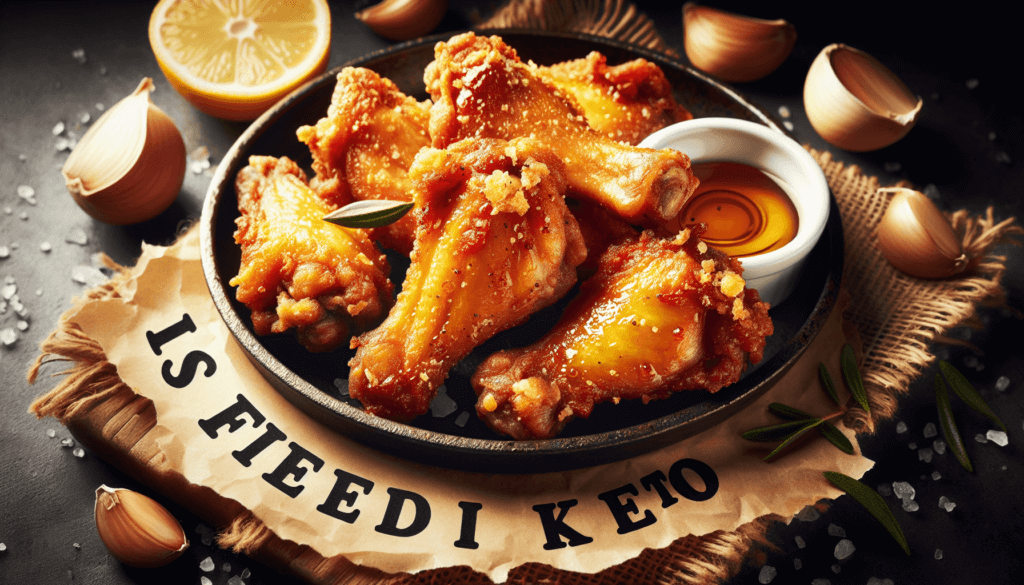You’ve heard all the buzz about the ketogenic diet and its potential health benefits, but you can’t help but wonder if your beloved fried foods fit into this low-carb, high-fat way of eating. Well, get ready to have your taste buds tickled and your questions answered because we’re here to uncover the truth: is fried food keto? In this article, we’ll explore the compatibility of fried indulgences with the keto lifestyle and provide you with valuable insights on how to enjoy your favorite crispy delights while staying on track with your ketogenic goals. Let’s dive in and discover if fried food truly has a place in your keto journey.
Understanding the Keto Diet
What is the Keto Diet?
The Keto Diet, short for Ketogenic Diet, is a low-carbohydrate, high-fat diet that has gained popularity for its potential weight loss and health benefits. It involves drastically reducing carbohydrates and replacing them with fats, forcing your body to enter a metabolic state known as ketosis.
How does it work?
When you consume foods high in carbohydrates, your body breaks them down into glucose, which is the primary source of energy. However, on the Keto Diet, with limited carbohydrate intake, your body is unable to produce enough glucose for energy. As a result, it starts breaking down stored fats into ketones to fuel your body. This shift from carbohydrate-burning to fat-burning is the foundation of the Keto Diet.
Benefits of the Keto Diet
Many individuals turn to the Keto Diet for its potential benefits beyond weight loss. Some studies suggest that it may help improve insulin sensitivity, reduce inflammation, and enhance mental clarity. Additionally, some people follow the Keto Diet to manage certain health conditions, such as epilepsy and type 2 diabetes. However, it is important to note that individual results may vary.
What Makes Food Keto?
Macronutrient Ratios
To be considered keto-friendly, food must adhere to specific macronutrient ratios. The general rule of thumb is to consume around 70-75% of your daily calories from fat, 20-25% from protein, and only 5-10% from carbohydrates. This ratio ensures that your body remains in a state of ketosis.
Low Carbohydrate Content
Carbohydrates are restricted on the Keto Diet. Foods that are low in carbohydrates, such as leafy green vegetables, avocados, and nuts, are considered keto-friendly. This is because they have a minimal impact on blood sugar levels and help maintain ketosis.
Moderate Protein Content
While the Keto Diet focuses on high-fat consumption, it also includes a moderate intake of protein. Protein is an essential nutrient that helps maintain muscle mass and supports various bodily functions. However, excessive protein intake can potentially interfere with ketosis. Therefore, it is important to consume an appropriate amount of protein based on your individual needs.
High Fat Content
Fat is a crucial component of the Keto Diet. It provides the majority of your daily caloric intake and serves as the primary source of energy in the absence of carbohydrates. Healthy fat sources, such as avocados, olive oil, nuts, and seeds, are staples in a keto-friendly diet.

Fried Food and the Keto Diet
What is Fried Food?
Fried food refers to food that has been cooked in hot oil or fat until it reaches a crispy and golden texture. It is a popular cooking method that is used for various types of food, including vegetables, meats, and even desserts. However, the high-fat content of fried food raises concerns about its compatibility with the Keto Diet.
Is All Fried Food High in Carbohydrates?
No, not all fried food is high in carbohydrates. While many traditional fried foods, such as french fries and breaded chicken, are high in carbohydrates due to their breading or coating, there are keto-friendly alternatives available.
Effects of Deep-Frying on Carbohydrate Content
Deep-frying can have varying effects on the carbohydrate content of food. The cooking process itself does not add carbohydrates, but the type of coating or batter used can significantly contribute to the carbohydrate content. For example, a deep-fried chicken with a flour-based coating would be high in carbohydrates, while a chicken coated in crushed pork rinds or almond flour would be lower in carbohydrates.
Can Fried Food Fit into a Keto Diet?
With careful consideration and modifications, fried food can indeed be incorporated into a keto diet. The key is to choose low-carb coating alternatives, opt for healthy cooking oils, consider air-frying as an alternative to deep-frying, make homemade fried food with keto ingredients, and experiment with different protein sources.
Keto-Friendly Fried Food Options
Choose Low Carb Coating Alternatives
When preparing fried food on a keto diet, it is crucial to choose low-carb coating alternatives. Some suitable options include crushed pork rinds, almond flour, coconut flour, or a combination of these. These alternatives can provide a crispy texture without significantly increasing the carbohydrate content.
Opt for Healthy Cooking Oils
Selecting the right cooking oil is essential for both health and taste. When it comes to keto-friendly fried food, oils with high smoke points and healthy fat profiles are recommended. Examples include avocado oil, coconut oil, ghee, and olive oil. These oils not only add flavor to your fried food but also provide healthy fats that support ketosis.
Consider Air-Frying as an Alternative
Air-frying has become a popular cooking method for those following a keto diet. It allows you to achieve the crispy texture of fried food without excessive oil. Air-fryers use circulating hot air to cook food, resulting in a healthier alternative to deep-frying. This method requires little to no oil, making it ideal for keto-friendly fried food.
Make Homemade Fried Food with Keto Ingredients
One of the best ways to ensure that your fried food is keto-friendly is by making it at home with keto-approved ingredients. This way, you have full control over the coating, oil, and overall composition of your meal. Homemade fried food using keto ingredients can be an excellent way to enjoy your favorite dishes while staying in ketosis.
Experiment with Different Protein Sources
Incorporating a variety of protein sources in your fried food can help add flavor and nutritional diversity to your keto meals. Instead of relying solely on chicken or beef, try experimenting with seafood, tofu, or even vegetables. This allows you to create a wide range of keto-friendly fried food options.

Nutritional Considerations
Caloric Density of Fried Food
Fried food often has a higher caloric density compared to other cooking methods. This is due to the additional fat absorbed during the frying process. While fat is an essential component of the keto diet, it is important to be mindful of portion sizes and overall caloric intake, especially if weight loss is a goal.
Importance of Portion Control
Portion control is vital when incorporating fried food into a keto diet. While it may be tempting to indulge in larger servings of your favorite fried dishes, it is important to remember that excessive calorie consumption can hinder weight loss and potentially kick you out of ketosis. Monitoring portion sizes can help maintain the balance between enjoying fried food and achieving your health goals.
Monitoring Macronutrient Intake
Maintaining the appropriate macronutrient ratios is crucial on the Keto Diet. When including fried food in your diet, it is important to consider the overall macronutrient content of your meal to ensure it aligns with your keto goals. This means balancing the fat, protein, and carbohydrate content of your fried food with the rest of your daily intake.
Health Effects of Fried Food
Impact of High Fat Consumption
While the Keto Diet promotes high fat consumption, it is essential to choose healthy fats and practice moderation. Consuming excessive amounts of unhealthy fats, such as those found in heavily processed fried foods, can have negative health consequences. Opting for healthier cooking methods and ingredients can help mitigate potential risks.
Can Fried Food Increase Risk of Heart Disease?
Fried food, particularly when cooked with unhealthy oils or consumed in large quantities, has been associated with an increased risk of heart disease. It is important to prioritize the quality of fats and moderation when indulging in fried food within the context of a keto diet. Incorporating other heart-healthy ingredients and cooking methods is advisable.
Potential Negative Effects of Deep-Frying
Deep-frying, when not done properly, can lead to the formation of harmful compounds, such as acrylamide and advanced glycation end products (AGEs). These substances are formed during the high-temperature cooking process and have been linked to various health issues. Paying attention to cooking temperatures and reducing overcooked or burnt portions can help mitigate these potential risks.
Keto Lifestyle and Moderation
Maintaining a Balanced Keto Diet
Embracing a keto lifestyle involves maintaining a balanced and diverse diet. While fried food can be enjoyed in moderation, it is important to prioritize nutrient-dense whole foods, such as fresh vegetables, healthy fats, and high-quality proteins. Incorporating a variety of cooking methods and ingredients ensures a well-rounded and sustainable keto lifestyle.
Splurging on Occasions
Occasional splurges on fried food can be a part of a balanced keto diet. Whether it’s celebrating a special occasion or simply indulging in your favorite treat, allowing yourself to enjoy fried food while practicing moderation can help prevent feelings of deprivation and promote a healthy relationship with food.
Being Mindful of Overall Diet Quality
While fried food can be keto-friendly, it is crucial to maintain an overall diet that is nutrient-rich and diverse. Relying heavily on fried food, even if it fits within the macros of a keto diet, may lead to nutritional imbalances and inadequate intake of essential vitamins and minerals. Ensure that fried food is just one component of a well-rounded keto diet.
Other Factors to Consider
Individual Variations and Tolerance
It is important to consider individual variations and tolerance when incorporating fried food into a ketogenic diet. Some individuals may find that certain fried food, despite being keto-friendly, affects their ketosis levels or causes digestive discomfort. Paying attention to your body’s response and adjusting accordingly is key.
Personal Goals and Preferences
Personal goals and preferences play a significant role in determining the role of fried food in your keto lifestyle. Some individuals may choose to avoid fried food altogether, while others may find enjoyment and satisfaction in including it occasionally. Aligning your choices with your goals and personal preferences ensures a sustainable and customized approach to the keto diet.
Seeking Professional Advice
If you have specific dietary concerns or underlying health conditions, it is advisable to consult with a healthcare or nutrition professional before making any significant changes to your diet. They can provide personalized guidance and ensure that your keto diet, including the inclusion of fried food, is safe and appropriate for your individual needs.
Conclusion
Fried Food Can Be Keto-Friendly When Prepared Carefully
With the right modifications, fried food can be made keto-friendly without compromising ketosis. By choosing low-carb coating alternatives, opting for healthy cooking oils, considering air-frying as an alternative, making homemade fried food with keto ingredients, and experimenting with different protein sources, you can enjoy the crispy goodness of fried food while staying within the guidelines of the Keto Diet.
Incorporating Fried Food into a Balanced Keto Diet
When incorporating fried food into your keto diet, it is crucial to maintain a balanced and diverse meal plan. Prioritizing nutrient-dense whole foods, practicing portion control, and monitoring macronutrient intake will help ensure that your fried food fits into the overall context of a healthy keto lifestyle.
Enjoying Food while Maintaining Ketosis
The Keto Diet should not be a restrictive or joyless eating plan. It is essential to find a balance between enjoying the foods you love, including fried food, and maintaining ketosis. With mindful choices, moderation, and attention to overall diet quality, you can savor the flavors of fried food while reaping the potential benefits of the ketogenic lifestyle.


